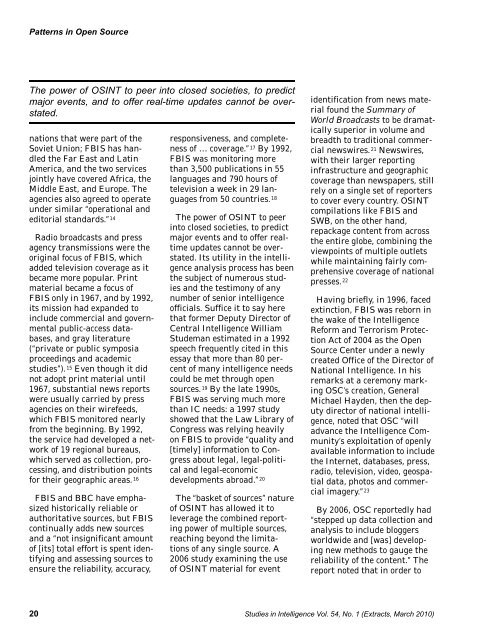Studies in Intelligence - The Black Vault
Studies in Intelligence - The Black Vault
Studies in Intelligence - The Black Vault
You also want an ePaper? Increase the reach of your titles
YUMPU automatically turns print PDFs into web optimized ePapers that Google loves.
Patterns <strong>in</strong> Open Source<br />
<strong>The</strong> power of OSINT to peer <strong>in</strong>to closed societies, to predict<br />
major events, and to offer real-time updates cannot be overstated.<br />
nations that were part of the<br />
Soviet Union; FBIS has handled<br />
the Far East and Lat<strong>in</strong><br />
America, and the two services<br />
jo<strong>in</strong>tly have covered Africa, the<br />
Middle East, and Europe. <strong>The</strong><br />
agencies also agreed to operate<br />
under similar “operational and<br />
editorial standards.” 14<br />
Radio broadcasts and press<br />
agency transmissions were the<br />
orig<strong>in</strong>al focus of FBIS, which<br />
added television coverage as it<br />
became more popular. Pr<strong>in</strong>t<br />
material became a focus of<br />
FBIS only <strong>in</strong> 1967, and by 1992,<br />
its mission had expanded to<br />
<strong>in</strong>clude commercial and governmental<br />
public-access databases,<br />
and gray literature<br />
(“private or public symposia<br />
proceed<strong>in</strong>gs and academic<br />
studies”). 15 Even though it did<br />
not adopt pr<strong>in</strong>t material until<br />
1967, substantial news reports<br />
were usually carried by press<br />
agencies on their wirefeeds,<br />
which FBIS monitored nearly<br />
from the beg<strong>in</strong>n<strong>in</strong>g. By 1992,<br />
the service had developed a network<br />
of 19 regional bureaus,<br />
which served as collection, process<strong>in</strong>g,<br />
and distribution po<strong>in</strong>ts<br />
for their geographic areas. 16<br />
FBIS and BBC have emphasized<br />
historically reliable or<br />
authoritative sources, but FBIS<br />
cont<strong>in</strong>ually adds new sources<br />
and a “not <strong>in</strong>significant amount<br />
of [its] total effort is spent identify<strong>in</strong>g<br />
and assess<strong>in</strong>g sources to<br />
ensure the reliability, accuracy,<br />
responsiveness, and completeness<br />
of … coverage.” 17 By 1992,<br />
FBIS was monitor<strong>in</strong>g more<br />
than 3,500 publications <strong>in</strong> 55<br />
languages and 790 hours of<br />
television a week <strong>in</strong> 29 languages<br />
from 50 countries. 18<br />
<strong>The</strong> power of OSINT to peer<br />
<strong>in</strong>to closed societies, to predict<br />
major events and to offer realtime<br />
updates cannot be overstated.<br />
Its utility <strong>in</strong> the <strong>in</strong>telligence<br />
analysis process has been<br />
the subject of numerous studies<br />
and the testimony of any<br />
number of senior <strong>in</strong>telligence<br />
officials. Suffice it to say here<br />
that former Deputy Director of<br />
Central <strong>Intelligence</strong> William<br />
Studeman estimated <strong>in</strong> a 1992<br />
speech frequently cited <strong>in</strong> this<br />
essay that more than 80 percent<br />
of many <strong>in</strong>telligence needs<br />
could be met through open<br />
sources. 19 By the late 1990s,<br />
FBIS was serv<strong>in</strong>g much more<br />
than IC needs: a 1997 study<br />
showed that the Law Library of<br />
Congress was rely<strong>in</strong>g heavily<br />
on FBIS to provide “quality and<br />
[timely] <strong>in</strong>formation to Congress<br />
about legal, legal-political<br />
and legal-economic<br />
developments abroad.” 20<br />
<strong>The</strong> “basket of sources” nature<br />
of OSINT has allowed it to<br />
leverage the comb<strong>in</strong>ed report<strong>in</strong>g<br />
power of multiple sources,<br />
reach<strong>in</strong>g beyond the limitations<br />
of any s<strong>in</strong>gle source. A<br />
2006 study exam<strong>in</strong><strong>in</strong>g the use<br />
of OSINT material for event<br />
identification from news material<br />
found the Summary of<br />
World Broadcasts to be dramatically<br />
superior <strong>in</strong> volume and<br />
breadth to traditional commercial<br />
newswires. 21 Newswires,<br />
with their larger report<strong>in</strong>g<br />
<strong>in</strong>frastructure and geographic<br />
coverage than newspapers, still<br />
rely on a s<strong>in</strong>gle set of reporters<br />
to cover every country. OSINT<br />
compilations like FBIS and<br />
SWB, on the other hand,<br />
repackage content from across<br />
the entire globe, comb<strong>in</strong><strong>in</strong>g the<br />
viewpo<strong>in</strong>ts of multiple outlets<br />
while ma<strong>in</strong>ta<strong>in</strong><strong>in</strong>g fairly comprehensive<br />
coverage of national<br />
presses. 22<br />
Hav<strong>in</strong>g briefly, <strong>in</strong> 1996, faced<br />
ext<strong>in</strong>ction, FBIS was reborn <strong>in</strong><br />
the wake of the <strong>Intelligence</strong><br />
Reform and Terrorism Protection<br />
Act of 2004 as the Open<br />
Source Center under a newly<br />
created Office of the Director of<br />
National <strong>Intelligence</strong>. In his<br />
remarks at a ceremony mark<strong>in</strong>g<br />
OSC’s creation, General<br />
Michael Hayden, then the deputy<br />
director of national <strong>in</strong>telligence,<br />
noted that OSC “will<br />
advance the <strong>Intelligence</strong> Community’s<br />
exploitation of openly<br />
available <strong>in</strong>formation to <strong>in</strong>clude<br />
the Internet, databases, press,<br />
radio, television, video, geospatial<br />
data, photos and commercial<br />
imagery.” 23<br />
By 2006, OSC reportedly had<br />
“stepped up data collection and<br />
analysis to <strong>in</strong>clude bloggers<br />
worldwide and [was] develop<strong>in</strong>g<br />
new methods to gauge the<br />
reliability of the content.” <strong>The</strong><br />
report noted that <strong>in</strong> order to<br />
20 <strong>Studies</strong> <strong>in</strong> <strong>Intelligence</strong> Vol. 54, No. 1 (Extracts, March 2010)





![Combat Support in Korea [270 Pages] - The Black Vault](https://img.yumpu.com/49796461/1/190x71/combat-support-in-korea-270-pages-the-black-vault.jpg?quality=85)











